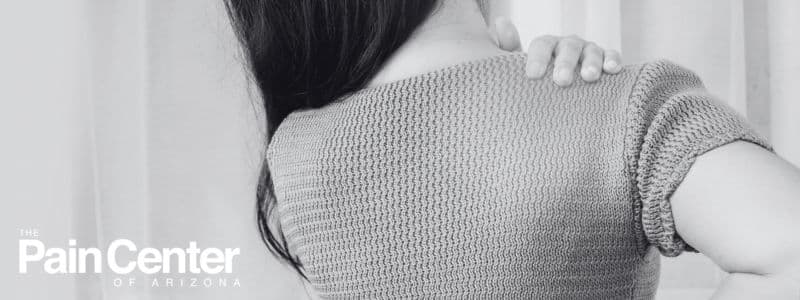While pain in the upper back is not a very common spinal disorder, it can cause significant discomfort and pain when it does occur. The most common causes of upper back pain are muscular irritation (myofascial pain) and joint dysfunction.
While there can sometimes be an injury to a disc in the upper back (such as a thoracic herniated disc or degenerated disc) that causes severe upper back pain, such injuries are usually very rare.
In this blog on upper back pain, we’ll look at the following topics:
- Is upper back pain rare?
- What causes upper back pain?
- Additional causes of upper back pain
- When should I worry about upper back pain?
- Treatments for back pain offered at The Pain Center
Is Upper Back Pain Rare?
Upper back pain is rare because what we call the thoracic spine (also referred to as the upper back, middle back, or mid-back) is very different in form and function than the cervical spine (neck) or the lumbar spine (lower back).
The neck and lower back are designed to provide us with mobility, but the thoracic spine is designed to be very strong and stable to allow us to stand upright and protect the vital internal organs in the chest. Because this section of the spinal column has great stability and only limited movement, there is generally little risk of injury or degeneration in the upper back over time.
Because there’s little motion and great stability throughout the upper back (thoracic spine), this spine section does not tend to develop common spinal disorders, such as a herniated disc, spinal stenosis, degenerative disc disease, or spinal instability. These conditions can cause upper back pain but are exceedingly rare in the upper back.
Because of this stability and lack of motion, anatomic causes of upper back pain cannot be found in most cases. An MRI or CT scan will rarely image an anatomic problem amenable to any surgical solution for upper back pain.
What Causes Upper Back Pain?

Upper back pain can occur due to trauma or sudden injury or through strain over time. For example, in recent years, upper back pain has become a familiar complaint from people who work at computers most of the day. Upper back pain often occurs along with neck or shoulder pain.
Additional Causes of Upper Back Pain Include:
- Poor posture
- Car accidents
- Diabetes (often resulting in nerve damage)
- Medical conditions (scoliosis, osteoarthritis, fibromyalgia, certain cancers, etc.)
- Lack of exercise
- Muscle strain
Most cases of upper back pain are due to one (or both) of the following: muscular irritation (myofascial pain) and joint dysfunction.
The shoulder girdle attaches by large muscles to the scapula (the shoulder blade) and the back of the thoracic rib cage. These large upper back muscles are prone to developing irritation (myofascial pain) that can be painful and difficult to work out.
Muscular irritation and upper back pain are often due to either de-conditioning (lack of strength) or overuse injuries (such as repetitive motions). Muscle strains, sports injuries, auto accidents, or other injuries can all result in pain from muscular irritation.
The ribs connect with the vertebrae in the thoracic spine by two joints that connect with each side of the spine, and dysfunction in these joints can result in upper back pain.
When Should I Worry About Upper Back Pain?
Upper back pain can be a temporary problem in mild cases such as pulling a muscle or having a stressful week. When upper back pain prolongs for over a week, and chronic pain symptoms emerge, you should contact your healthcare provider.
Other signs that you should seek medical support include:
- Numbness or weakness in the arms, legs, or buttocks
- At-home care is ineffective (over-the-counter pain relievers, applying heat or ice)
- Pain persists for more than a week
- Pain limits activities or interrupts sleep
- Pain is severe
- Difficulty breathing
Treatments for Back Pain Offered at The Pain Center

TPC Spine Stim
TPC Spine Stim is for patients with chronic back or leg pain who haven’t responded to alternative, conservative treatments in the past six months. TPC Spine Stim works by implanting a nerve stimulation device into your spine. This device delivers low-voltage electrical currents to areas of the spine to reduce the pain signals causing chronic pain.
TPC Spine Fuse
TPC Spine Fuse targets spinal degeneration, usually brought on by stenosis, spondylolisthesis, and related conditions. It works to alleviate pain due to pressure on the spinal cord and instability that causes painful movements of the vertebrate.
In this procedure, a small incision goes into the back under live X-ray guidance. A device is placed between the spinous processes that fuse the segment. This gives the back stability, where the bones shift forward and backward. Our procedure can also be done through alternative approaches (a posterior, oblique, or lateral approach) depending on each individual’s needs.
TPC Spine Lift
TPC Spine Lift is a spinal decompression treatment to relieve spinal nerve pressure pain. This procedure is designed to aid patients suffering from chronic pain due to spinal stenosis and related conditions.
Our procedure uses the Vertiflex procedure, lifting the space where the lumbar vertebrae are narrowing or bulging (often a result of spinal stenosis). This process is done under a live X-ray as guidance, placing a small device that opens up the pressure area.
TPC Sacral Fuse
TPC Sacral Fuse provides stability to the joints of patients with sacroiliac joint dysfunction. This condition can cause pain with too little or too much movement in the joints.
Under live X-ray guidance, a small device is placed into the sacroiliac joint, fusing the joint. Fusing the joint creates better stability, targeting pain caused by movement and instability.
TPC Peripheral Nerve Stimulation
TPC Peripheral Nerve Stimulation offers pain relief to patients suffering from peripheral neuropathy and related conditions. A small electrical wire is surgically implanted along the damaged nerves and delivers rapid electrical pulses. These pulses feel like mild tingles, called paresthesias, and help to minimize pain.
TPC Spine Decompress
TPC Spine Decompress offers a minimally invasive method of pain relief for patients with spinal stenosis. In this treatment procedure, a small trocar needle is used to locate where the narrowing that’s causing the pain is occurring. Following this, we use a small instrument called the rongeur to remove excessive bone or tissue to open the area.
Published On: June 12, 2013
Updated On: March 30, 2023



